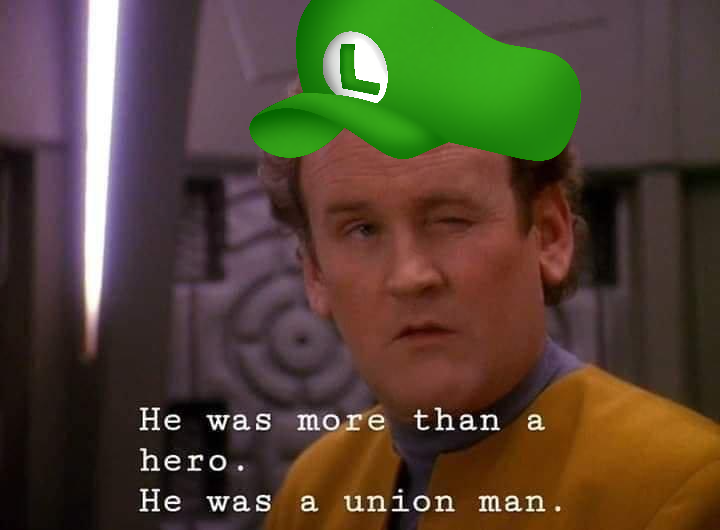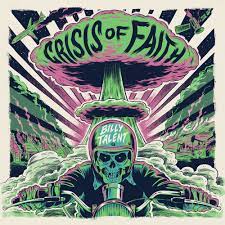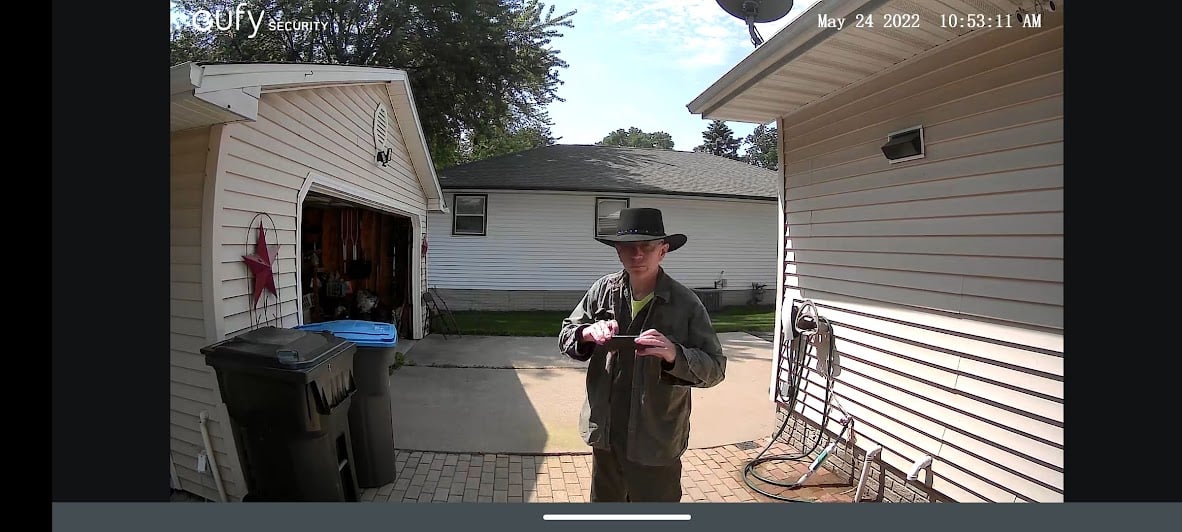- cross-posted to:
- [email protected]
- cross-posted to:
- [email protected]
Solar now being the cheapest energy source made its rounds on Lemmy some weeks ago, if I remember correctly. I just found this graphic and felt it was worth sharing independently.
Imagine how steep that line would be if the fossil fuel lobbies hadn’t been fighting it tooth and nail all these years
much more important: we’d be years ahead with storage technology.
Gotta keep prices high yo
It would be less steep because solar costs would have come down earlier.
That would make it steeper, no?
Without saying anything about politics, environment, or source:
Why, for the love of Satan, does this graph have only 2 data points per source?
Why use a line chart 📉 for that?
This is clear bar chart territory 📊.
I know it’s not ideal, but a bar chart design could either focus on the difference over time for each source, or the difference between sources at each time. This plot gives a good representation of both the differences between sources and the change in time for each source. It really drives home how far solar prices have fallen relative to other sources and in absolute terms.
The cost of the panels themselves doesn’t seem to have gone down nearly that much.
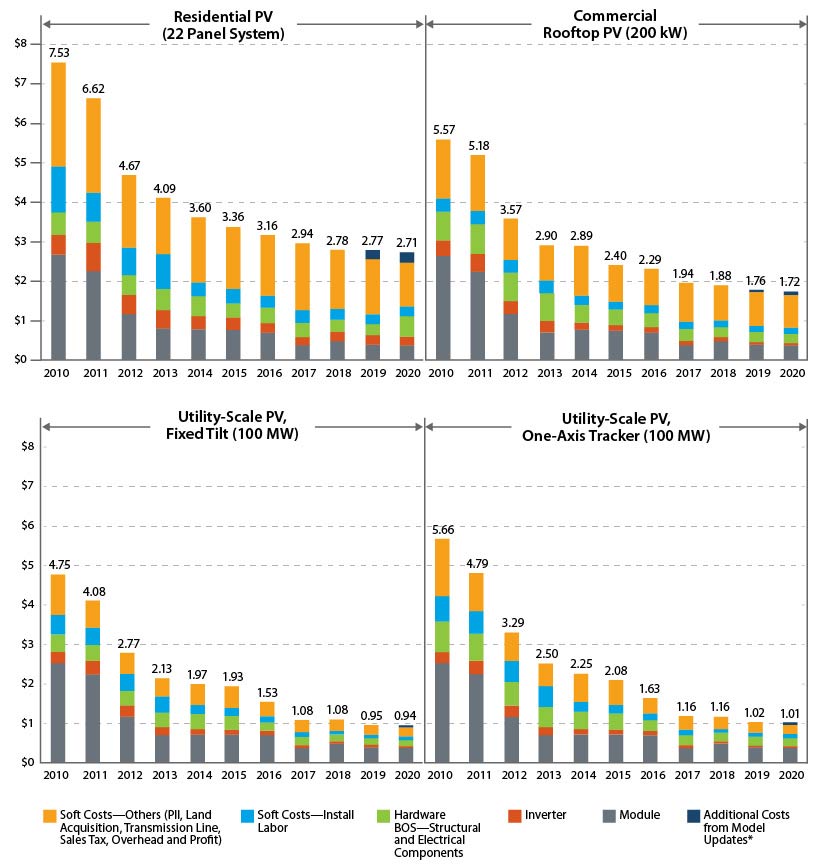
OP’s data is LCOE, which takes into account much more than $/MW. Rather importantly, expected operating liftetime is a major component (and historically THE major economic downside of PV).
IIRC, LCOE is calculated for utility-scale solar, which has seen a 500% decrease according to your chart.
Finally, Neither chart specifies, but if OP’s is in constant dollars and yours isn’t that would explain a lot as well.
And this shows exactly why investing in nuclear is not the answer every tech bro thinks it is. Its far cheaper to built renewable and more importantly far far far quicker.
It is AN answer, but also not the only answer. Generating and moving power around is extremely complex and just seeing “Solar cheaper per Watt” and defining it as the best in all cases is silly. If you changed the axis to be size per MWh, then you would draw a totally different conclusion.
It was the answer. Now solar is so cheap that spamming panels and investing into ways to save the excess energy seems cheaper. By the time nuclear plants are done you’re going to be at least 8 years into the future. Solar panels however are directly implementable. And even cheaper now.
Solar still doesn’t work at all night, no matter how cheap it gets.
It’s not very useful for most of Northern Europe and birth America during the winter months. Even if it was free you’d still need alternatives.
Yup, and you’re not going to be able to make enough batteries, and if you could, it would be prohibitively expensive.
There are other options for energy storage, but they all have massive caveats. We’ll need something reliable as a backbone until we find a good way to store power.
This is the issue: you can use batteries to store energy for the night during the day. Batteries that store over longer periods such as long cloudy spells and large seasonal differences are too expensive. On the other hand, on a global scale this is really mostly a concern in Northern Europe (where I happen to live).
Even overnight storage is expensive.
But yes, it needs to work in both the summer and the winter, so anything not at the equator is going to have seasonal challenges. I’m excited about a lot of innovating battery proposals, such as stacking heavy boxes and hydrogen generation, but none of those are anywhere near capable of production scale. The massive gorilla in the room is using EV batteries during the night and recharging them during the day (the car would reserve enough for your morning commute), but that’s largely theoretical and charging infrastructure is far from sufficient to make that work at scale (not to mention I don’t think there are enough EVs). We have trouble making enough batteries to keep up with EV demand, so there’s no hope of using conventional batteries to actually transition a large countries anytime soon.
So until we solve those problems, we need an energy backbone. Nuclear is a great option, especially if we can destigmatize it so construction can be cheaper. I live in an area that would be perfect for it (Utah USA, just stick it in the desert on the other side of the mountains), yet people keep blocking every proposal out of FUD. So a lot of our energy comes from coal and gas, and we sell a our excess to California, which is utterly stupid since we have geography that collects pollution and makes the air unhealthy to breathe.
Sweden represent :,(
Scotland has been meeting pretty much its entire energy demand with renewables for a good while now, because there are options other than solar, primarily wind
Renewables. Not solar.
8 years is a drop in the bucket when it comes to long term production.
It’s really not even AN answer. It’s so expensive to build them, requires hoards of highly specialised people to build and operate, takes decades to build all the while were relying on fossil fuels still until it can generate power, has a bigger carbon impact than renewables due to massive amounts of concrete used in building decommission and waste storage, is more expensive per mw, and while on average safer than most types of power plant, if something unexpected happens shit goes extremely bad.
It just has way way way too many downsides compared to wind or solar or basically any other renewable to the point its just not really worth pursuing.
I mean given that new nuclear plants haven’t been made in quite some time it’s too be expected that the average cost rises as costs for maintaining older plants also rises as they reach the end of their projected life cycle. In a few years when solar arrays have risen maintenance costs it won’t change the fact that it’s an essential power source, so the same logic should be applied to all clean energy.
With approaches to reducing emissions we should take a “yes and” approach. Yes nuclear is a way to reduce emissions and we need to invest in solar wind and hydro. This is true regardless of what we put at the front of that sentence!
With approaches to reducing emissions we should take a “yes and” approach.
UGH, YES, THANK YOU! Perfect should not be the enemy of good.
I’m all for renewables but keep in mind a nuclear plant can produce 24/7 regardless of conditions while many renewables cannot. I don’t see an issue with diversification here rather than pointlessly advocating for a one-size-fits-all solution.
A nuclear plant can’t “produce 24/7 regardless of conditions”. Obviously natural disasters affect them. Nuclear plants need water so any flooding or tsunami can affect them. They also need maintenance because they are very complicated water boilers.
They require a lot of educated people to run them, whereas a wind turbine requires a few guys to check on them sometimes. Solar just requires some dudes to brush off the panels occasionally. That can probably be automated too.
Solar’s lack of moving parts is something people overlook, too. Hail storms supposedly rarely damage them, and if they do, you can just replace individual panels.
Navy has been operating nuclear submarines for 80 years. You don’t have to be that educated
I used to work with a guy who was a nuclear tech before getting out of the military and he legitimately made me concerned about the level of intelligence they require to do the job.
Nuclear is cleaner, safer, and cheaper, though…
We need a base load until batteries are better but its not cleaner, safer or cheaper. Solar got cheaper than nuclear a few years ago.
It is not, at all. The large amounts of concrete needed for nuclear plants as well as the decommissioning and storage of waste means they are far worse for the environment than wind
Demand isn’t a 24/7 constant value.
Nuclear doesn’t match demand and supply.
Nobody said it was, and I have no idea what the statement, “Nuclear doesn’t match demand and supply” is supposed to mean.
You said nuclear can produce 24/7. As in thats why its better than renewables. The issue you speak of is supply matching demand right? Renewable don’t match demand. Well neither does nuclear.
Where did I say it was better than renewables? I said we need to diversify, and that means using more than one thing.
Because it doesn’t help. Renewables want to be paired with something that can easily be spun up and down as needed. Nuclear doesn’t fit that model. It tends to make it worse, because cheap energy we could be getting from solar or wind has to give way to the nuclear baseload instead.
It’s something of the opposite problem of the sun not shining at the same time the wind doesn’t blow. At times where you have tons of both, you want to store them up for later. Nuclear forces a situation where you have to do that even more.
Except we don’t have a practical way to store any of this energy and there is always a constant baseline demand that can be met in part by techniques that don’t need to be constantly spun up and then back down and work day and night, rain or shine.
Ammonia believe it or not.
Yes diversification is important too. But that still doesn’t mean nuclear is worth it.
I’d be willing to bet that the cost of nuclear energy derived electricity is going up because most countries haven’t been building new plants for the last like 50 years
Average age of a nuclear power plant in the USA: 42 years
Average age of a nuclear power plant in the EU: 31 years
Average original intended operational lifespan: 20-40 years
To put their age into perspective, the average US nuclear plant was built closer in time to the Trinity nuclear test in 1945 than to today (along with any other plant 39 years or older)
This doesn’t prove that nuclear energy is bad, only that slowly degrading nuclear energy technology from decades ago is bad
You can look up the costs of nuclear in a country like France which is easily the most consistent builder of nuclear in the west and its not much better.
The average age of a nuclear power plant in France is 37 years
They have 56 total reactors, and have only built 6 in the last 30 years (with the most recent one being connected to the grid in 1999, 24 years ago)
Which is a fraction of the nuclear the United States has.
I mean, it’s a fraction in the sense that 2/3rds is a fraction (The US has 92 operating nuclear reactors as of 2023)
Even if that’s true, it’s not something we can change without more than a decade of investment. Good batteries will be here before that, if not here already.
The reason we don’t build nuclear power plants anymore (including small modular), is because they’re insanely expensive, produce only a small amount of power compared to you can produce with renewables, and always come with cost overruns. Nuclear power is the techsploitation of of tbe 60’s and 70’s. Most governments look at the economics now and realize they can do solar plus storage for a fraction of the immediate and long term cost.
I wonder if fusion will ever be competitive with photovoltaic at this rate. There will still be decades for solar prices to drop.
At some point decades from now maybe? I still think nuclear and fusion research are important for human civilization, I just think it’s stupid to waste money on building power plants using nuclear technology in its current state.
No it doesn’t. Cheap solar is great but even if it was $0, you’d still need some other tech to provide electricity when the sun is down. So it’s either gas, batteries, nuclear, etc. but you can’t just use solar alone.
And until batteries get good enough, nuclear is the cleanest option we have.
They could. Someday.
Nuclear can, now.
shouldn’t we be working towards a better someday than settling for a worse today?
Time is running out on the climate, how many decades can we wait for the “perfect” solution to show up when we have a good enough one right now they can help?
How long will it take for us to get good enough batteries? If it’s less than 10 years, then it’s less than the time to build a nuclear power plant.
Oh, and the answer may very well be that we already have batteries that are good enough.
How long will it take for us to get good enough batteries?
Including the time to manufacture and install them at utility scales (we are talking powering an entire nation out of batteries for hours), way more than a decade.
Batteries are already being installed on grids but they can only help so much smooth out power delivery. They are very very far from having the ability to completely take over an entire grid.
Yes, like wind. Which is also much cheaper and cleaner than nuclear.
Germany has tons of solar and winds and yet it is pretty common to have neither (windless nights) at which point the entire grid needs to be powered by non renewables. That’s a lot of standby power.
Bro do you know how power storage works
Diversifying our energy needs in case of a crisis isn’t a bad idea, but we do need to prioritize renewable energy.
The problem right now is that we need to find better ways to turn renewable energy into stable, reliable power. The power production problem is highly dependent on balancing power generation and demand, and any excess energy must be stored, used, or wasted.
The main benefit of gas/coal/etc. is that we can (almost) always control the output to a close margin based off of demand projections, which are typically updated every 15 minutes. That being said, the drawbacks of using this form of generation are obvious and need to be addressed.
For renewables like solar and wind, we can’t always predict the output, so in the larger scale of power balance, we need to supplement it with something that can make up for fluctuations in generation. In the current system, this is from conventional sources.
The goal is to implement a robust energy storage system, ideally one that can hold a huge amount of excess renewable power during the day (largely due to solar), and reliable output that power when it is needed (higher demand at night). I would love to see the day where our nation is fully powered by renewables, and I’m super happy to see that there have been pushes to build up renewables, but the target scenario relies on big advancements in storage.
I would suggest anyone who is interested in what I said to look up “california duck curve solar” for some reading on what challenges solar overgen presents in bright and sunny states.
All that being said… we can do it! I sincerely hope we reach a point where we can phase out dirty generation across the globe, but it will take a lot of time and effort.
source: taking several power systems courses as part of my EE degree
Much of this can be solved or mitigated with pumped hydro, green hydrogen, thermal batteries, or maybe compressed air. The problem is that all of this requires infrastructure spending.
California’s duck curve specifically can be flattened with desalination. Any excess power that California makes with solar beyond the grid’s demand should just go into making more fresh water. Having too much solar energy is really just a problem of not having systems you can turn on when you do. Even if you only get 30% of the power back with green hydrogen it is power you had too much of in the first place.
One gallon of gasoline is equivalent to 33.7kWh of electricity and your average American home uses 29kWh of electricity a day. We’ve been perfectly fine wasting energy for over a century, I don’t see why we should pearl clutch now.
The problem is that all of this requires infrastructure spending.
Agreed. This is spending that our country isn’t willing to do, mostly because of what we already have (both in terms of infrastructure and in political influence). Personally, I hate this.
As for Cali’s duck curve issue, desalination is a great idea, but expansion of renewables and storage should really come first. Keep in mind that the current Cali grid generates much less dirty power during the day, where solar covers a majority of demand. Should we divert that solar power to desalination, we would need to ramp up dirty power generation during the day, and we would continue to generate dirty power at night.
Even if you only get 30% of the power back with green hydrogen it is power you had too much of in the first place.
While I agree with you, we also have to consider what this would do at scale. The 70% of excess power that you lose here translates to wear on the solar panel systems that is never realized into power. That is, the systems will wear at the same rate, but the amount of power you can utilize over the lifespan of the systems is decreased. It’s still a better solution than not implementing these at all, but I’d be wary as to how reluctant our society would be to the spending, especially if the ratio of cost to utilization(?) becomes skewed.
We’ve been perfectly fine wasting energy for over a century, I don’t see why we should pearl clutch now.
Well, that’s an issue in of itself. It’d be great if we could waste less power in conventional generation, but it’d be even better if we could match or even beat that with renewables. I hope we can reach a point where everyone can agree to implement renewables sooner than later, but I don’t see dirty power’s political influence allowing for changes until renewable is equal to or better than dirty power. Which sucks, but a lot about our political system sucks.
As for Cali’s duck curve issue, desalination is a great idea, but expansion of renewables and storage should really come first. Keep in mind that the current Cali grid generates much less dirty power during the day, where solar covers a majority of demand. Should we divert that solar power to desalination, we would need to ramp up dirty power generation during the day, and we would continue to generate dirty power at night.
I’m not talking about using solar to make fresh water. I’m talking about using the excess power to make fresh water as to not put more power into the grid than it can use. The duck curve is often used as a sticking point for why nuclear doesn’t work, because nuclear needs a base load and the duck curve is a base load nuclear can’t accommodate.
Obviously more storage to use more renewables but also, just use the excess for something. Nuclear can boil water to desalinate, use excess electricity to desalinate via RO. Given the infrastructure you could even use this to water California’s immense farms. (But power companies like making profit so… no times of free power, climate change instead please)
While I agree with you, we also have to consider what this would do at scale. The 70% of excess power that you lose here translates to wear on the solar panel systems that is never realized into power. That is, the systems will wear at the same rate, but the amount of power you can utilize over the lifespan of the systems is decreased. It’s still a better solution than not implementing these at all, but I’d be wary as to how reluctant our society would be to the spending, especially if the ratio of cost to utilization(?) becomes skewed.
With how cheap PV panels are per mW it is not really an issue about how efficiently the power is stored. We’d obviously want to recycle them but generally the fact that you don’t pay for fuel means eventually the power is free. There was a study done in LA where if you covered just the parking lots with solar you could provide power for the entire city (if storage was available obviously)
A chemical battery will be somewhere like 80% or more efficient but they can’t hold that for weeks, months, or years.
Pumped Hydro is ideal, the Hoover Dam produces 4.5 billion kWh of electricity a year. With pumped hydro you can effectively do the same thing in places rain doesn’t do it for you. Bath county for instance has 24,000mWh of capacity. They’re obviously really dangerous if they break and also damage ecosystems.
But green hydrogen can be done mostly anywhere, stored more easily (obviously not as easy as fossil fuels or well most things) and can be transported.
There was a study done in LA where if you covered just the parking lots with solar you could provide power for the entire city (if storage was available obviously)
That’s really more of an indictment on LA having too much parking than anything else.
Put the solar panels on the roofs. Replace the worthless parking lots with more productive buildings. And, obviously, quit forcing everybody to drive everywhere.
I agree but I feel that is even more aspirational than renewable energy.
Personally I want high speed rail, commuter rail, trams, and bike infrastructure but I’ll probably be dead by the time any of that happens if it does at all.
The whole base load situation is largely over hyped, as a diverse and slightly overbuilt network of renewable would compensate for fluctuations with minimal storage needed. Iirc you would just need 118% capacity with a 2 hour storage buffer to achieve stability rates on par with a traditional grid. And nuclears small footprint actually hinders it when filling a base load requirement, as nuclear provides a lot of power at a single location, but if you want to base load a national grid you want a little power at lots of locations. (Which can be argued that SMRs will fill that role, but that’s a whole other argument)
What are SMRs?
Small modular reactors. It’s an unproven technology that tech bros love to talk about like its magic and going to fix everything.
Yeah, solar + wind + highly connected grids can go a long way to balance loads and make up for the intermittent nature of wind and solar.
Also every bit of atomic energy we use now humans have to pay for for centuries to keep the waste safe
Normally these guys are all about passive income and buying over subscriptions and things like this but if your actions lead to generations having to pay for it suddenly it’s not as bad…
Pay for centuries to keep it safe? We literally just throw it in an old mine shaft and fill it with concrete, it’s really not that monetarily or resource intensive
We have reactor designs that use already spent fuel, we just aren’t building them. We have enough spent fuel for centuries, and afterwards the reprocessed fuel is much less radioactive, and only for a few decades.
The folks that work at the nuke plant around here have this really cute saying. They say working there is like playing “Hide and seek for a grand a week” (it’s an old saying so needs adjusting for inflation) Then they like to say “the cost of labour has no impact on the cost of electricity”
They also like to shit on wind power.
I’m not sure it’s tech bros falling for the nuclear lie, it’s rather the wannabe rich invest boys in my experience.
The same people falling for NFTs
No it doesn’t.
The price of solar can’t continue on this trend forever. There’s a point of diminishing returns.
Yes and no, the progress of solar array technology continues unabated, with multiple areas of research that are beginning to reach commercial applications. Module conversion efficiencies now are in the 20% range, but heterojunction cells, or Gallium Arsenide, or Perovskites, or any number of other possible advancements could easily put efficiencies up into the 30% range.
That being said, the price of the solar modules themselves has already shunk to a small piece of the cost to build a solar array, with the bulk of the costs now being the support structures, wiring, electrical equipment, labor, development, etc. And those costs aren’t going to decline, they’d still be there even if the solar panels themselves were free, so they effectively set a floor to the cost reductions we’re seeing.
I can see that critical thinking isn’t your strong suit, but I’m willing to comment it out with you instead of just down voting.
If the price of solar is already the lowest -and still dropping- then how is the most expensive option that takes about a decade to implement a better option for right now? This apparent point of diminishing returns is only beginning to manifest in even lower prices than this 2019 chart. And this diminishing returns point is only in the cost of the panels dropping; they are still getting better in technology and improving efficiency while maintaining low prices. If your argument is “solar can’t continue on this trend forever” -no one expects anything to consistently drop almost 90% every decade. Of course it will level out. And when it does, it will STILL be the cheapest option.
Critical thinking isn’t my strong point?
Nighttime. Winter.
Even if solar power was free it still wouldn’t fucking work.
It will never work during those times.
So nuclear - which is clean and sustainable - can phase out the fossil fuels that have to be burned during the nighttime and winter.
Or did you think that the cost of solar panels dropping correlated with a perfect drop in energy costs for everyone?
“critical thinking skills” twat.
Dang, it’s almost like it was worth all the research money the government crammed into it in the long run, unlike what my dad said to me a million times.
What surprises me, in a way, is that photovoltaics are literally 3,5 times cheaper than just mirrors reflecting light onto a tower. It got REAL cheap. Wish it’d go further!
The mirrors are the not the expensive part.
What is? Thermal to electricity conversion?
Yup. Steam turbine generators have a lot of moving parts, and moving parts break
Got it, thanks
The installation just keeps getting higher. Now to add onto mine I need a load of additional equipment that was not required when my first lot of enphase inverters was installed. Also what was quoted for the labour and materials that are not the panels and inverters has almost tripled in 4 years. Have to get the roof sorted before I go ahead with it and the higher output panels and inverters mean that I would get about another 1.5kw in the same space compared to my first installation.
Rooftop solar is the most expensive way to do it. The graph above is for utility scale systems. Roofs are always custom jobs and they’re priced accordingly. Utility scale uses racks that are all the same for an entire field.
If rooftop was priced alone on the chart in OP, it’s be around the price of nuclear.
To ballpark some numbers on the contractor side, I charge about $100/hr to install it now - 4 years ago that might have been $60/hr.
Really depends on where you are, sadly.
Where I am, a normal 6.6kw system (panels + inverter + installation) can cost as low as about $1,950usd nothing more to pay. Good for 25 years. (Higher end panels and such can go up to about $4500usd for a 6.6-7kw system)
Damn it’s like 9k to 10k cad where I live.
Yikes, yeah, that sounds sadly normal for a lot of places.
Sweet, now get the panels and installation cheaper so I can afford to put it on my house
We had a solar salesman come by once and told us he could lower our electricity bill the same amount as it would cost us to install the solar panels.
I knew there was something up with this but I decided to let him continue to talk anyways. He does this whole presentation with solar panels and how great they are for a good 30 minutes.
Finally we get to the money part and he keeps emphasizing that they will lower my electricity bill so the cost of them will be made up there. I push him for the total cost of them plus installation and I about died.
$30,000??? They literally wanted me to pay for these for 30 years. As long as my mortgage! Aaaaah!!!
I had a few come over and I was already in the market for solar so I entertained them for a minute. I told them “OK, give me some invoices for your other customers so I know what you charge. Black out the names, I dont care - I just want the prices of your services and materials”. These idiots would not stop calling me or coming over to my house for months. I kept telling them “Unless you give me actual, real world dollar amounts, I won’t consider it”.
Those solar sales guys are worse than used car salesmen.
Some companies in my area are installing them for free, and taking the utility difference. It’s a novel approach.
I want a discount on my electricity if I have to have a solar array on my land. Even if it were otherwise free.
Similar here, got a quote from a company that wanted $45,000 to only cut my bill in half. Said my roof having so many levels due to being a 1.5 story made it hard to install and get good coverage. Guess I get to just burn coal power then because that price is ridiculous
That’s about 10 times the price it costs to have a full system installed in other parts of the USA.
I put in a small solar backup power system myself for $1500. It’s not enough to power HVAC or any big appliances but it is enough that I can have my fridge, freezer, TV, and Internet going off the grid whenever there’s a power outage.
Just to save $100 a month.
100x12x30
If I save 100$ a month, sign me up
But they will still have to make the monthly payments for the solar panels. So, their real savings will only start after they paid off the loan in 30 years. lol
Further lowering panel cost isn’t going to significantly cut that price. Cost of labor is the major part of that.
People always focus on rooftop solar, but it’s horribly expensive compared to a field of panels. The economics of scale will almost certainly keep it that way.
What we should be looking at is community solar, where neighborhoods invest in a solar field together.
Field solar has serious environmental implications as long as the ground over which the panels are placed isn’t already developed for a different use. Covering parking lots, big box stores, and freeways with solar is much more environmentally sound.
covering already used land with solar is very compelling. either do that or a green roof
Wouldn’t that be a less sustainable use of land?
I guess maybe not if we are talking tall building, where the roof surface area may not be sufficient for the entire building. But it would be a waste not to make use of all the unused rooftops
Yeah, in some countries, land is at a premium. No way would it be wasted on just solar panels. Rooftop installations make the most sense.
They are even testing putting them afloat on dam reservoirs.
I’ve always thought that in the neighborhoods where everyone lives in townhomes and mini apartments a shared multi floor parkade with solar and maybe also wind on top should be a thing. Even if the solar is just covering the parkade’s power usage.
Pretty clearly shows why there’s no future for nuclear power.
Even for filling gaps in renewables, peaker plants are getting cheaper and don’t take 15 years to build.
This is always a weird take to me because it always ignores the fact that nuclear has been screwed continuously for decades. If any other tecbology, renewable energy or not, had the same public and private blockers did it would also have no future.
it always ignores the fact that nuclear has been screwed continuously for decades
On the contrary: I’d say it implicitly relies on that fact, which is why the argument that it takes 15 years to build is valid. Because nuclear has been screwed, there’s no pipeline of under-construction plants coming online any sooner than that.
It may not be fair that nuclear’s been screwed, but that doesn’t change history. The only thing that matters is what’s better when construction is starting in 2023.
While I don’t think it relies on that fact, you are correct with the rest.
My dude have you even followed any public discourse regarding renewable energy? There are literally very vocal people trying to push that wind turbines are putting cancer into children and that birds will go extinct because of them. There was discourse for many years that solar power was a waste of money and energy and it still gets pushed aside as being a household solution with no larger merit. Get out your selfmiserable bubble that only poor nuclear energy has heavy opposition and find a solution what to do with nuclear waste lmao.
Right cause a few crackpots on Twitter are comparable to multi generational governmental and NGO propaganda campaigns.
My brother in Christ that fact you think there aren’t solutions to nuclear waste when there very clearly are simply proves my point.
Your crackpots on Twitter are literally fossil fuel and nuclear lobbied conservative politicians on all levels around the globe. But my poor nuclear is getting a bad rep :(
Ima be honest with you. I dont care thst much what you make of a punchline followed by a “lmao”. The way you read discourse and think this is some sort of conspiracy about all innocent nuclear getting the stick. Go read your rightwing thinktank’s paper and save the World or something idk.
Oh there we go. Clearly I’m right wing cause I disagree with you. Good lord you Americans are insufferable.
:D
You know its always the same with you Scotts :D
Nuclear waste already has a solution.
Most power plants, after exhausting the SOLID material for some time, deposit it in big cylindrical cement coffins ON SITE, so It can decay until harmlessness.
Nuclear waste is, if not 100%, all accounted for and taken care of.
Kyle Hill has a nice video about It if you want to learn more.**
Those are vocal minorities, not majority. Solar and wind didn’t have several nuclear catastrophes to shift most public opinion into the gutter. Plants were poorly managed, cut corners, and ignored obvious warnings that could have prevented disaster. https://ocw.mit.edu/courses/22-011-nuclear-engineering-science-systems-and-society-spring-2020/dfc5cc5e7a23d03bc1674e9423eeaece_MIT22_011S20_NuclearEnergy.pdf
Here’s a link to an opinion piece on the matter, compiled with some sources. Nuclear is a viable option and focus on nuclear waste is shortsighted. Fossil fuels already produce waste in the form of greenhouse gas emissions and it’s doing more damage to the planet than a comparablely tiny amount of nuclear waste.
Nuclear has been screwed by its own track record.
Why do you think its had such a wide coalition of public and private opponents?
Well that’s simply false. Its been screwed by ignorance propaganda and fear mongering.
You clearly don’t understand the other side.
Sure buddy. And you clearly do.
Actually I do. I was a nuclear booster in the 1990’s because it means cheap limitless pollution free power.
Except that they don’t actually deliver on that promise. You can have safe nuclear or cheap nuclear, but if it’s safe it’s not cheap, and the public rightfully won’t accept something that can require evacuating hundreds of square miles for decades.
So wise one, where are those cheap safe nuclear power plants we keep hearing about since 1950?
In France. They standardized the designs so each one isn’t a one-off and they trained more people to work in the field.
So the user above me actually gave the the answer so kudos to them but to further answer your question, there are no actually cheap reactors because the fight to actually build one is so insanely expensive. Where I live they’d been trying to build a reactor for over a decade. Constant lawsuits and legal battles after already obtaining permits and everything. Its ballooned the cost by tenfold. Why? Because of constant NGO pressure from the likes of greenpeace. So congrats, you win. They aren’t cheap cause of the hell we’ve made for ourselves.
the other side is big oil
LOL. It’s “big solar” that’s eating their lunch.
yeah but I want the power to work between 4 pm and 8 am
“I’ve ignored and circumvented every known safety measure, and everything went wrong” - Whoever the fuck said that, 2023
Making up straw men to defeat?
We have extensively documented history supporting exactly what you’re trying to argue against
if you cite chernobyl that’s exactly what you’re saying. it’ll never happen again because no one’s that dumb
Fukushima happened in “smart” Japan because it was cheaper to put the backup generators in the basement than to build a concrete podium taller than the tsunamis that previously hit the site.
Capitalism will always choose cost over safety. Even then nuclear ends up going way over budget.
Then we shouldn’t leave energy security and the climate in the hands of capital. Energy should be nationalised.
Has there been a scenario where the technology itself is to blame? The contamination aspect of nuclear waste is well known and preventable, if costs are being cut on radioactive waste disposal (or in the case of a certain Japanese power company, ignoring warnings from the government on how to reduce ocean contamination in the event of an earthquake) a nuclear installation’s fate is sealed…
As far as I can see, the only downsides with nuclear IMO is that it takes multiple decades to decommission a single plant, the environmental impact on that plant’s land in the interim, and the initial cost to build the plant.
In comparison to Solar it sounds awful, but before solar, nuclear honestly would have made a lot of sense. I think it may even still be worth it in places that have a high demand for constant power generation, since Solar only generates while the sun’s about, and then you’re looking at overnight energy storage with lithium-based batteries, which have their own environmental and humanitarian challenges
Uranium powered fission technology, not all nuclear. Look into Thorium
yeah you can do throium, and there are some compelling reasons to, but uranium is fine enough. anti-nuke isn’t about actual technical enlargements. the anti nukes hate nuclear fusion too
“Today there are about 440 nuclear power reactors operating in 32 countries plus Taiwan, with a combined capacity of about 390 GWe. In 2022 these provided 2545 TWh, about 10% of the world’s electricity.”
There have been two major reactor accidents in the history of civil nuclear power – Chernobyl and Fukushima Daiichi. Chernobyl involved an intense fire without provision for containment, and Fukushima Daiichi severely tested the containment, allowing some release of radioactivity.
Yes- a track record of one plant failing due to Soviet incompetence and political blunders; and the second failing due to checks notes a 9.0 magnitude almost direct earthquake and ensuing 133 ft tsunami.
the earthquake didn’t even damage the plant, they thought of that. the tsunami knocked out the power lines and bad generator placement led to loss of power for cooling. build reactors to passively cool themselves (which should just be a mandatory safety feature on new reactors tbh, it’s not a big ask and improves safety a lot) and fukushima type accidents become impossible. that plant was so old that the original operating license was going to expire a week after the quake and the only guy who died had a heart attack. fukushima-sized death tolls happen in the rooftop solar installation industry every year, totally unreported.
you mean the part where it generated a shit ton of carbon free reliable power while killing fewer people per watt-hour what any other method? with outdated 60’s technology too? yeah sure sounds like a failure
This.
And it is always a question how they calculated handling of nuclear waste.
There are options, we can use coal and natural gas for on demand power to fill the gaps in renewables, we don’t have to quit all at once. New ideas for energy storage and comming around, some of them might be useful for small towns, others for remote places.
there is very very very little nuclear waste.this is complete handwringing. it can be buried and forgotten.
Bigger issue is the carbon costs and pay back periods. Nuclear (unless you’ve got sources otherwise stating) is green in it’s planning phase but not as often in execution. A shit ton of concrete is used, and the plants rarely operate at the capacity they are expected to (or have in the past). Open to revision but that’s my current understanding.
They are a massive upfront carbon cost and only become carbon neutral or negative relative to fossil fuels 20+ years down the line.
Do you have data on that? A modern nuclear power plant is going to be in the 500-1000+ MW range. I have a hard time imagining that even operating at half capacity that they do not offset the carbon used for concrete within a relatively short order. But if that is in fact the case I’d love to see data saying so, so that I can correct my thinking.
Kyle Hill has a nice video about power plants waste disposal, one of cleanest methods there is.
edit: he actually went to the plant and showed how it’s done
He literally hugged and kissed a canister of nuclear waste to show how safe it is. Kyle Hill is my hero
deleted by creator
indeed. when you kill nuclear, the reality is natural gas and sometimes coal is the real replacement
nuclear waste, by definition of being radioactive, is the only wast that goes away on it’s own if you leave it sit for long enough
I was considering whether this is just a shitpost, but your other comments suggest that you’re completely serious. It does not go away. Radioactive decay causes multiple transitions between radioactive elements until it ends up as lead, which does not decay further.
Of course, it should also be said that it’s better to have no waste than waste that eventually turns into lead.
And that it’s still better to have waste than waste which also happens to be toxic.right, but when it lands at lead it’s no longer radioactive waste, which is the part everyone’s scared of. chemical waste doesn’t just go away like that.
I think that’s too simplistic of a view. Part of the high cost of nuclear is because of the somewhat niche use. As with everything, economies of scale makes things cheaper. Supporting one nuclear plant with specialized labor, parts, fuel, etc is much more expensive then supporting 100 plants, per Watt.
I can’t say more plants would drastically reduce costs. But it would definitely help.
Of course It is, the incompetent and ignorant people that try to hinder it’s use is the problem
The nuclear industry is 100% responsible for the operational record of the nuclear industry.
Cool, so you’re either going to have to completely get rid of all the nimbys and people that don’t understand nuclear, then build a massive population of qualified workers to build them and staff them and then fund them in the hundreds of billions for at least 2 decades to build up the knowledge base required to be able to build them quickly and efficiently.
Or accept the reality that nuclear is dead in the water.
So the people who built that reactor were incompetent and ignorant?
Reading comprehension isn’t really your strong suit, eh? “The incompetent and ignorant people that try to hinder it’s use is the problem”
If you are hired to do a task and then overrun the budget by 14B$ I wouldn’t exactly call it furthering the cause. More like incompetence and/or trying to detail the project.
the most dangerous part of nuclear power is not using enough
The source article actually talks about this and measured data suggests nuclear cost actually went up, despite more capacity being built.
This is the first time, I’ve read this anywhere. More sources/studies would be really important. And there is lots of interpretations to be had on the why, but assuming the article isn’t completely off the mark, that’s cold, hard data suggesting that your (perfectly reasonable) assumption is actually wrong, after all.
Interesting, I’ll have to look at the source article.
But as far as I’m aware the total amount of nuclear power has been decreasing in recent years. This might change with China’s future plants.
I’ve also read about small modular reactor designs gaining traction, which would help alleviate the heavy costs of one off plants we currently design and build.
Not saying the source is wrong, just saying that’s what I used to form my opinion.
china’s been building dozens of reactors, all of a common design which is the correct way https://en.wikipedia.org/wiki/Hualong_One
bullshit regulatory costs can increase infinitely without nay change to the underlying engineering or economics. that’s 100% the cause of the price increses
Possible. But well, whether these regulations actually are bullshit or not, kind of doesn’t matter. A dumb solar panel won’t ever need to be regulated as much. If that’s what makes it cheaper, it still is cheaper.
They’ve had 75 years to get the cost down. It’s still going up.
Congratulate yourself then. The propaganda you and your ilk continue to spew is the reason for this.
Oh it’s just the meanies keeping the poor nuclear industry down! 😆
big oil pushes this stuff, by the way. because they know the reality that when nuclear plants get shut down, natural gas replaces it
because of oil funded fear pushing pseudoscience based restrictions
This chart is worthless, so it doesn’t show anything. Like 2 data points for this? Seriously? And there was a pandemic and a war since then…
So what has changed?
I just installed a 9.3 kW system with individual microinverters under each panel for grid stability and it is absolutely amazing how much you can power all day without threatening a massive bill at the end of the month. I still import power at night, but the power companies usually have agreements where you get credits for all wattage exported to the grid to cover your imported power at night, because both parties win in that contract.
Do you mind sharing what price one can expect for an install that size (or similar)? I’ve been wanting to install a system like that on my house for a couple years. Now that prices on hardware are more affordable it’s becoming very tempting. I’d love to do it myself.
It depends, $180/mo for 25 years is the agreement and it’s directly connected to the grid both ways which required additional work from the power company to inspect and approve. I think given the projections it was rated for about 25,000 kWh per year * 25 years (approaching 85% efficiency after 30 years), which is a good amount of total production for my needs. Edit: it’s worth considering what $180/mo will look like in 5 to 20 years… it will probably be significantly cheaper compared to other power sources because it’s generated locally.
Yes the time value of money can work heavily in your favor when projecting that far out. The way the housing market is right now, I might be here for a while 🤣 Thanks for the response!
Well, looking at these prices here listed seems like solar in US is really costly for some reason? I have a 9.8kWp system in europe, installed a year or two ago, and it cost me 12k euros. Out of that, I’ll get 2ke back in tax rebates, so 1ke for 1kwp.
During summertime, I get 1500kWh approx in a month. I have one AC unit and two electric cars, and a 24U server rack, and can live without electricity bills some months.
Get 800kwh to 1mwh a month depending on sun coverage. Cost me 23k paid in full.
AUS here, I just got a 10kw system installed last month, cost 9.5k AUD for everything. So far monitoring the generation, I’ll be getting paid next time the bill comes around :)
deleted by creator
I hate that PGE got rid of the export.
Where are you located and what was the total cost? When I last got quotes 12 years ago, it was insanely expensive ($ 70k ) .
deleted by creator
Is it free standing or rooftop? Many consumer companies didn’t do free standing when I last looked into it.
deleted by creator
my bill has gone up 89%
Well the electric exec’s kid needs a third Ferrari to go with the third Lamborghini they got last year! You’re not gonna be so heartless as to deprive a 32 year old child of their birthday wish are you?
Thanks, China.
And Germany!
It’s frustrating seeing a graph showing the price of electricity going down while my utility prices go up. Does this take into account infrastructure cost?
deleted by creator
Yeah energy prices have gone through the roof but apparently it’s cheaper in every way except nuclear - and we don’t even have nuclear around here
The data stops in 2019. It’s completely outdated. The world is in chaos since covid. But anti nuke propagandists don’t care much about these “details”.
Hi, I’m a human being, not an “anti nuke propagandist”. I just checked, if there’s newer data, and well, there is, but no one seems to have formatted that in a way yet, which you or me would be willing to digest.
Personally, my impression has been that the solar industry was one of the industries that was pretty much completely unaffected by COVID, so I felt this graph was still perfectly relevant.
But even if it were strongly affected, I do not see why our technological progress in manufacturing, that we had in 2019, should evaporate with COVID.
There is inflation and a rise in natural catastrophes, but I feel like those would affect nuclear and others roughly proportional.Well, if you omit batteries then you are mostly true, although with covid there was a huge shortage of electronic components that would affect solar a lot, at least depending on where you live. Batteries is a big unknown now, because with all the demand for it, we simply can’t build enough batteries to feed all the grids with it.
Alright, yeah, good point with the batteries. I’m hoping the batteries in electric cars will double up as storage for the grid (already happening today), but also that there’s just enough redundancy with other renewables.
That’s your big takeaway here? Anti nuke? It’s just one line on the graph, you’re being hysterical.
https://www.powerengineeringint.com/renewables/lcoe-for-offshore-wind-now-on-par-with-coal-bnef/amp/
Covid actually had almost no impact on the prices and they continued to level off a little lower. The surprising one is the onshore wind remaining on par with solar and continues to drop (albeit slowely).
Gas skyrocketed in Europe. Oil is going yo-yo. How does this have no impact on the price?
The graph is talking about LCOE. I am talking about LCOE. The other comments are talking about LCOE. You are talking about spot price on input goods. One of us here is talking about something different.
Levelized Cost of Electricity
Levelized Cost of Electricity (LCOE) is an economic measure used to compare the lifetime costs of generating electricity across various generation technologies. The lifetime costs for generation can be categorized into the following groups: • Capital Costs: up-front costs to construct a power plant • Operation and Maintenance (O&M) Costs: costs incurred to run a power plant. These costs can be sub-categorized into fixed and variable costs. Fixed O&M costs are incurred regardless of the plant generating electricity; they are comprised of personnel salaries, security costs, insurance, etc. Variable O&M costs are directly linked to the generation of the power project. Fuel costs for conventional plants also vary with output. • Disposition Costs: costs typically incurred at the end of the useful life. The disposition costs for certain generation technologies, such as nuclear power plants, can be huge. In most of the instances, the disposition costs for the solar and generation projects are assumed to be zero because the scrap value of the equipment generally should cover the cost of removal.
As shown in the examples below, financing costs are internalized in the LCOE calculation. The LCOE methodology also considers various tax benefits, including depreciation that may provide a tax shield. LCOE is a useful tool as it allows comparison of various generation technologies with different capital costs, O&M costs, useful life, etc. LCOE can be viewed from an economic perspective as an “average” electricity price that must be earned by a specific generation source to break even. LCOEs are used as a relative scale to compare various technologies rather than an absolute measure informing investment decisions. Actual system planning must also consider reliability issues (such as availability at periods of peak demand) as well as other factors. Accordingly, LCOE is primarily used by policymakers for long-term planning, as well as devising incentive mechanisms. Developers and independent power producers may use the metric as a broad planning tool to compare the attractiveness of various generation technologies. Finally, investors are interested in LCOEs to understand long-term economic trends, especially for renewables, for which the decrease in cost has greatly improved their competitiveness.
Is this just the cost per raw Watt produced?
Is it a fair comparison vs conventional fuel-based power (coal/nuclear)?
Ie: if you wanted to build a plant capable of producing continuously, 24 hours a day, you would need some multiple of solar panels to produce an excess during daylight, and storage.
Not that drastic drops in solar costs aren’t bad, just what would the cost-per-watt be if you had to power an average city on just solar for a year?
Look at the subtitle on the chart, it’s levelized cost over the generator’s lifetime. So not including storage for any intermittent source like solar or wind
And not including the financing cost of buying up an this upfront.
I’m buying 36kWh solar array and it will be home made diy, used.parts and maximum jank and don’t paid upfront because that’s the only way it makes economic sense and that’s hoping it works for more than 7 years (break even point at my insolation level and and grid price (8.8$cad/kWh) and it only works with net metering)
Levelized cost averages the fixed costs over the lifetime of the generation
They’re generally comparing utility scale installations, not home rooftop solar though.
In my area, you don’t get any government incentives unless it is professionally installed. They get you coming and going.
Yes, I never even considered the subsidies, I know it’s not for me.
Anybody can claim the tax credit though. When you file the taxes it’s a box you enter a number into.
They don’t ask for proof, but you’d better keep your receipts just in case.
Hmmmm, interesting. Thanks.
Well you’ll never get a “fair” comparison, because the environmental effects are never properly priced into the consumer price.
Government subsidies work for getting new technologies out of the prototype stage and into practical deployment. Solar and wind are both good demonstrations.
Cool…but where’s offshore wind?
I’m not quite sure, why it was left out of that graph, maybe they didn’t have matching data, but it is shown here (from the same source article):
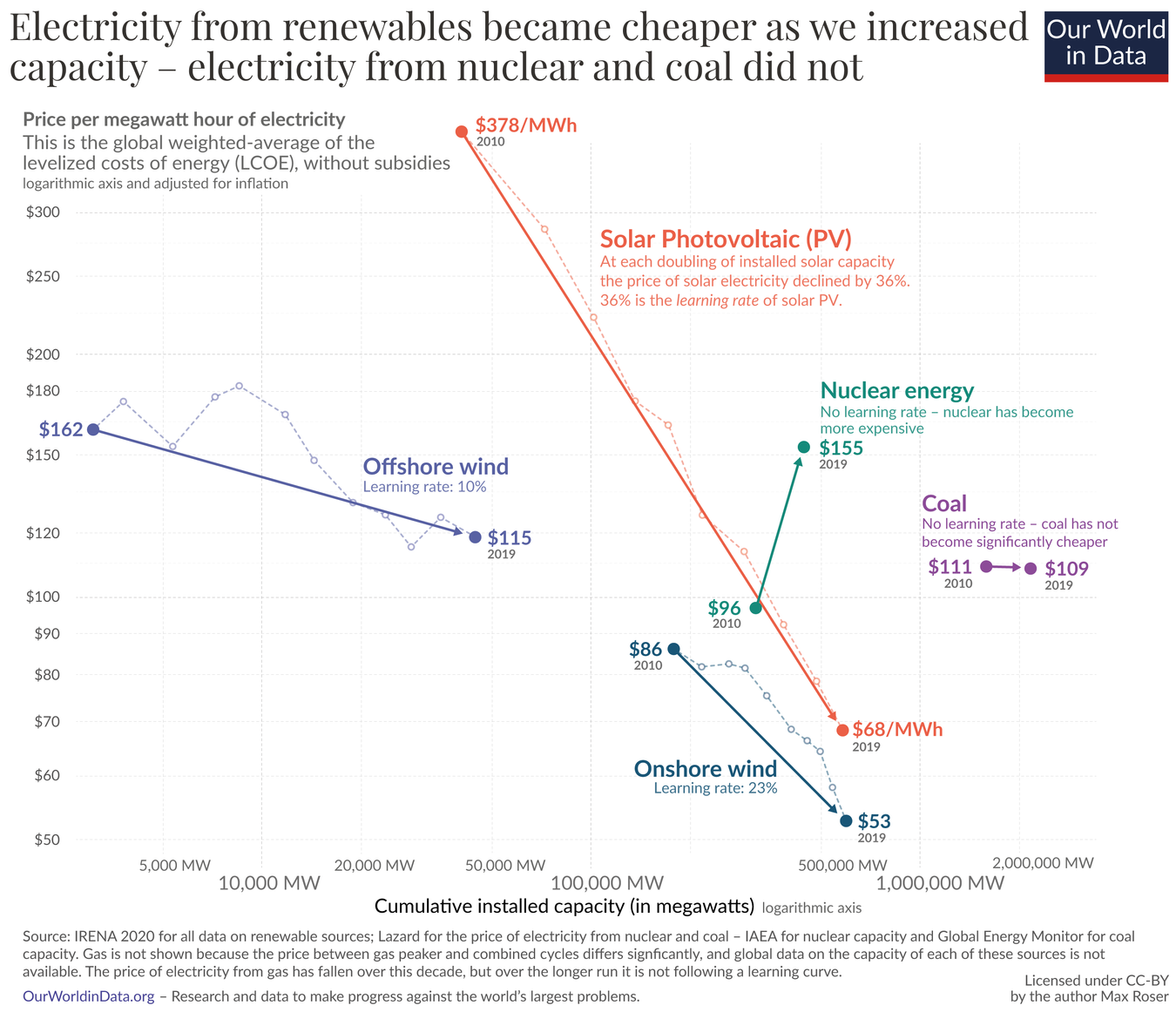
Clearly nuclear is the future!
You do realise solar and wind gets pricier and pricier to integrate as the level of steerable capacity decreases?
What you are looking at here is “cost to install ‘rated capacity * load factor’”. A big part of the reason renewables are still cheaper is that we have a lot of backup steerable capacity, mainly in the form of gas plants in the west and coal plants everywhere else.
Renewables dump electricity onto the grid and then say “here, buy this!”. And the only reason the grid can respond and say “sure” is that it can tell the steerable gas and coal plants “turn off for a bit, these other plants are dumping a crap tonne of capacity onto the grid”.
Given the insane challenge in building enough storage and/or enough transmission capacity, you are going to need some steerable capacity beyond 70-80% renewable to continue to have cheap integration of intermittent renewables. Do you want that to be based on fossil fuel?
If we wanted to treat renewable capacity in the same way as we have treated other generators, we should say “I want steerable capacity between 0-1200 MW” from this field of wind turbines!”. That would force the currently externalised cost of guaranteeing generation onto the builders of renewables.
Right now, a lot of the real cost is hidden elsewhere in the grid - so it’s no wonder it looks so cheap.
Please don’t misread my comment as being against renewables, which we need a lot more of. I’m against crappy accounting.
However, your point also goes ageinst nuclear as this technology is not really steerable either. It produces a base supply. The lack of quick control of nuclear plant output even led to highways beeing lit in the night in Belgium (way back) to burn off the over supply.
The only technologies that can be quickly adjusted up and down are, to my knowledge, gas, hydro an battery storage. In a strictly renewable scenario (0 fossil, 0 nuclear fisson) it is imperative to have a lot of controllable reserves. Currently the plan is to use a mix of (pump) hydro, h2 and biomass powered gas plants and batteries in all shapes and forms (li-Ion, reflow, heat…) to be able to compensate peaks. This all is way more costly than just using wind and solar and hope supply will always be higher than demand.
For those interested I always recommend the yt channel “just have a think”. It has really awesome content about green technologies and the current state of affairs concerning the long and hard journey to 0 carbon.
That is honestly an urban myth that nuclear isn’t steerable. It’s not steerable in the second, but it is extremely steerable in the hour or the day, which is more than plenty given that renewables output change by the hour or day, rather than the second.
Yes it’s not frequency management - for that we have pumped storage and batteries. But it sure as shit is steerable enough for matching up with renewables. The wind doesn’t goes from Beaufort 6 to Beaufort 1 within a second.
This is a very interesting rabit hole you sent me into. Thanks for that!
Btw. I don’t get why you’re beeing downvoted. This is a civilised discussion and your comments are fair and well presented!I started searching a bit about steering nuclear.
So as usual it doesn’t seem to be quite so simple. I found a paper from 2017 (in German https://publikationen.bibliothek.kit.edu/1000102277/121070976 ). interesting parts translated through deepl/chatGPT:
"The operating manuals of the NPPs show that they [nuclear power plants] exhibit considerable flexibility:
In the range close to full load (above 80/90% of the nominal Power), the output can be increased or decreased by up to 10% of the nominal output per minute. In the upper load range (above 50/60 % PNenn), the power plants can be regulated at 3.8-5.2 %/min (for some reactor types, this is reduced to around 1 %/min if individual fuel rods are defective).For comparison: In lignite-fired power plants, this value is around 3 %/min, 4 %/min for hard coal-fired power plants and 6 %/min for natural gas steam or combined power plants 6 %/min. Only gas turbines, at 12 %/min, are significantly faster.
The lower load range (between 20 and 60%) is also possible, but in discussions with power plant operators it became clear that this has not yet been used in regular operation (apart from start-up and shutdown operations) and is not used in regular operation."
Also it seems that changing output puts stress on the whole systen. As well cited from the paper:
“Another factor is the number of cycles that the plants can undergo. Each load cycle stresses the material and, with frequent repetition, leads to signs of material fatigue. Nuclear power plants were designed for a specific maximum number of cycles during their construction. In the upper load range – for example, a reduction in power from 100% rated power to 80% and back (100-80-100) – coolant temperature and pressure hardly change. Therefore, the power plants are designed for up to 100,000 cycles of such nature. However, in the lower load range, the alternating stress on the components increases, and the maximum cycle count decreases significantly. The cycle 100-40-100, for instance, is allowed only 12,000 repetitions. For the cycle rated load-zero load-hot-rated load (100-0-100), a maximum of 400 cycles is specified. Assuming a plant lifespan of 40 years, this would correspond to 10 of these events per year.”So there seems to be considerable flexibility but you don’t want to shut it off completely or run below say 50% of nominal power. Also start-up times from 0 seem to be very long (1-2 days). This might not be the perfect match for running together with renewables, but there are definitively possibilities. Even when it’s windy and the sun shines, renewables would need to be shut down and the more expensive nuclear plant would run and burn fuel.
Therefore, my opinion still stands: the ultimate goal should still be 0 burning stuff, 0 nuclear.Hey, likewise, thanks for a sensible debate.
I definitely think 0 nuclear is possible, just a lot expensive than “mostly renewable with some nuclear.”
I’ve commented extensively on this before here on Lemmy, let me copy pasta here:
Here’s a couple of good papers and articles on the topic:
A systematic review of the costs and impacts of integrating variable renewables into power grids - a large meta-study from Nature Energy showing that the externalised additional cost of integrating 1 MW of renewable production hits £40/MWh between 75% to 85% renewable penetration. Beyond that no studies have been done, but already at this level, renewable would be more expensive than nuclear (at auctioned build-prices today).
Real-World Challenges with a Rapid Transition to 100% Renewable Power Systems - finds that even if you set the Value of Lost Load to £40,000/MWh in a 100% renewable grid, you’ll still get power outages after 2030. It’s not equivalent to externalised cost of renewable integration, but is a heavy indicator that without forcing massive fines on renewable providers, the reserve capacity won’t be provided (it’ll be cheaper for them to just pay the fine). The study finds that a fine of £4 million (!) per required-but-not-fulfilled MWh is needed to encourage providers build the reserve capacity (through distribution, storage etc.).
How much can nuclear power reduce climate mitigation cost? - shows that nuclear will lower the cost of getting to zero carbon electricity product by 40%+, compared to refusing to use nuclear energy production.
Burden of proof: A comprehensive review of the feasibility of 100% renewable-electricity systems - shows some of the challenges of the assumptions that people make in thinking renewables will get us all the way there.
Projected Costs of Generating Electricity - shows that, all costs considered, nuclear remains an extremely cheap way to create energy, even up against renewables.
Local Complementarity of Wind and Solar Energy Resources over Europe: An Assessment Study from a Meteorological Perspective - shows that at least in Europe, wind and sun don’t anti-correlate (in other words, we’re not going to get energy from the sun on non-windy days and energy from the wind on cloudy days. Also shows there are many periods (days long) in Europe where we have don’t get neither sun nor wind. So storage will have to last us days across Europe.
Many of these articles refer to many other articles you may find interesting.
Overall, my point is that it does us (collective “us”, not just “you and me”) no good to argue that “it’ll be alright if we just commit to renewables”. One has to argue against these peer reviewed studies, done by experts in the field, many collecting and meta-reviewing many other studies, to argue that “renewables will be enough”.
And these are not “cooky studies” in “cooky journals”. Nature, Cell, Joule are some of the most respected journals, with the highest impact ratings and the authors & their reviewers have studied these topics for years.
I’m all for more renewables! But it won’t be enough!
Wind and solar complement each other. The sun often shines when the wind isn’t blowing. We have plenty of historical weather data on how long the lulls where neither would work for a given region. That tells you how much storage you need to fill the gap. Pad that out, and you’re good.
Nuclear does nothing to help this calculation. It’s just expensive.
Not only that, but we don’t have to do this all at once. The math often works out that getting to 95% renewable is far easier than shooting for 100%, with existing fossil fuel plants making up the remainder. This is fully achievable by 2030, by which point we want to drastically reduce emissions. Then we can worry about the last 5%.
There is no such plan for nuclear. If you had all the permits signed off and dirt being shoveled right now, then you would not have a single MW of new nuclear feeding the grid by 2030. They take too long to build. Budget and schedule overruns are the norm, and it’s a wonder that anyone is investing money into them at this point.
In fact, they aren’t. The US federal government has shown a willingness to sign permits for new nuclear plants. Nobody is buying, and there’s no mystery as to why.
deleted by creator
The reason nuclear plants take so long to build is because there is so much ignorant opposition to them. The same roadblocks that caused our global housing crisis get in the way of building clean nuclear energy.
also since fuel costs aren’t really a problem for nuclear power, you can just throw away excess generation. not the best idea but perfectly possible in a pinch
We just have to build a transatlantic power line - It’s always sunny somewhere in the world /s
yeah, do a nuclear backup for renewables. https://en.wikipedia.org/wiki/Integral_Molten_Salt_Reactor this reactor outputs solar salt, which can store energy efficiently for hours and allow load following
dat place called Scotland?
No, silly. That’s onshore. Scotland, see? Land means, y’know, on shore? I want to know about the windmills in the ocean.
(Do I have to put this here? /s)
Kind sir, with the current tendencies in overall temperatures that excite changes on the far north and south, you simply have to be patient till onshore become offshore just as you desire.


